Fire is a hazard in many industries. Sometimes the risk is quite evident, as when flammable gasses like hydrogen and propane are being produced or handled, but in other situations it is less obvious. In particular, dust can often be highly combustible.
A fire needs fuel, oxygen and an ignition source. Flammable gasses, vapors and dust provide the fuel, oxygen is present in most environments, and ignition can come from a spark or hot surface. Every fire is dangerous, but in more extreme cases combustion is so rapid as to cause an explosion.
Preventing fire and explosions is a top priority as no business or organization wishes to be responsible for causing death and injury. Additionally, the direct financial penalties of such events – punitive fines and increased insurance premiums— can cripple a previously successful operation.
Engineers needing to install equipment in areas where fire is a risk have two options: employ explosion-proofing techniques or adopt an “intrinsically safe” design approach (and these are not mutually exclusive). This White Paper from OMEGA Engineering answers the question, “what is intrinsic safety equipment?” Individual sections address:
A fire needs fuel, oxygen and an ignition source. Flammable gasses, vapors and dust provide the fuel, oxygen is present in most environments, and ignition can come from a spark or hot surface. Every fire is dangerous, but in more extreme cases combustion is so rapid as to cause an explosion.
Preventing fire and explosions is a top priority as no business or organization wishes to be responsible for causing death and injury. Additionally, the direct financial penalties of such events – punitive fines and increased insurance premiums— can cripple a previously successful operation.
Engineers needing to install equipment in areas where fire is a risk have two options: employ explosion-proofing techniques or adopt an “intrinsically safe” design approach (and these are not mutually exclusive). This White Paper from OMEGA Engineering answers the question, “what is intrinsic safety equipment?” Individual sections address:
- Meaning of intrinsically safety (IS)
- Choosing the right pressure transducer or load cell for IS environment
- Installation and risk management considerations
- Using a wind tunnel for calibration
- General Q&A
After reading this paper engineers and other technical specialists should understand the intrinsic safety concept and the benefits of applying it in their work.
what is an intrinsically safe equipment?
Intrinsically safe equipment is defined as "equipment and wiring which is incapable of releasing sufficient electrical or thermal energy under normal or abnormal conditions to cause ignition of a specific hazardous atmospheric mixture in its most easily ignited concentration." This is achieved by limiting the amount of power available to the electrical equipment in the hazardous area to a level below that which will ignite the gases.
In order to have a fire or explosion, fuel, oxygen and a source of ignition must be present. An intrinsically safe system assumes the fuel and oxygen is present in the atmosphere, but the system is designed so the electrical energy or thermal energy of a particular instrument loop can never be great enough to cause ignition. Intrinsic Safety (IS) is an approach to the design of equipment going into hazardous areas. The idea is to reduce the available energy to a level where it is too low to cause ignition. That means preventing sparks and keeping temperatures low.
Traditionally, protection from explosion in hazardous environments has been accomplished by either using EXPLOSION PROOF apparatus which can contain an explosion inside an enclosure, or PRESSURIZATION or purging which isolates the explosive gas from the electrical equipment. Intrinsically safe apparatus cannot replace these methods in all applications, but where possible can provide significant cost savings in installation and maintenance of the equipment in a Hazardous area. The basic design of an intrinsic safety barrier uses Zener Diodes to limit voltage, resistors to limit current and a fuse.
The alternatives are to design systems so oxygen is excluded (by purging with inert gas) or to isolate possible sources of ignition. This can be done either by putting equipment in enclosures strong enough to contain an explosion or by moving it outside the hazardous area.
In order to have a fire or explosion, fuel, oxygen and a source of ignition must be present. An intrinsically safe system assumes the fuel and oxygen is present in the atmosphere, but the system is designed so the electrical energy or thermal energy of a particular instrument loop can never be great enough to cause ignition. Intrinsic Safety (IS) is an approach to the design of equipment going into hazardous areas. The idea is to reduce the available energy to a level where it is too low to cause ignition. That means preventing sparks and keeping temperatures low.
Traditionally, protection from explosion in hazardous environments has been accomplished by either using EXPLOSION PROOF apparatus which can contain an explosion inside an enclosure, or PRESSURIZATION or purging which isolates the explosive gas from the electrical equipment. Intrinsically safe apparatus cannot replace these methods in all applications, but where possible can provide significant cost savings in installation and maintenance of the equipment in a Hazardous area. The basic design of an intrinsic safety barrier uses Zener Diodes to limit voltage, resistors to limit current and a fuse.
The alternatives are to design systems so oxygen is excluded (by purging with inert gas) or to isolate possible sources of ignition. This can be done either by putting equipment in enclosures strong enough to contain an explosion or by moving it outside the hazardous area.
When is intrinsic safety certification necessary?
Whenever equipment is being installed in an area where combustible material is present it is essential to take steps to minimize the risk of ignition. An IS design is accepted as an appropriate approach, although requires that the whole system be designed accordingly. It is not sufficient to just use intrinsic safety certified components.
An exception to the need for certification is made in the case of “simple apparatus”. This is the term used for very low power or passive devices that will not cause ignition. Good examples are thermocouples and RTD’s.
An exception to the need for certification is made in the case of “simple apparatus”. This is the term used for very low power or passive devices that will not cause ignition. Good examples are thermocouples and RTD’s.
How Does Intrinsic Safety Equipment Work?
Avoiding ignition entails minimizing both the available power and the maximum temperatures. Defining the maximum level of available power is complex, but in general terms can be considered as meaning voltage less than 29V and under 300 mA. A simpler view is to say that power must be less than 1.3 W. (Note that much instrumentation requires 24V and can often be designed to draw less than 500 mA; sufficient to meet IS certification in many situations).

Six classes define temperature levels. In general, equipment meeting the T4 designation is considered intrinsically safe because temperatures will not exceed 135°C (275°F) (equipment dissipating less than 1.3 W generally stays below this temperature).
Most applications require a signal to be sent out of or into the hazardous area. The equipment mounted in the hazardous area must first be approved for use in an intrinsically safe system. The barriers designed to protect the system must be mounted outside of the hazardous area in an area designated as Non-hazardous or Safe in which the hazard is not and will not be present.
Equipment which has been designed for and is available for use in hazardous areas with intrinsically safe barriers includes:
Most of the apparatus that is mounted in the Hazardous area will have to be approved and certified for use in the Hazardous area with an approved barrier designed for use with that apparatus. Some simple devices like thermocouples, Rtds, LEDs and contacts can be used in the hazardous area without certification as long as it is wired in conjunction with an approved barrier.

Six classes define temperature levels. In general, equipment meeting the T4 designation is considered intrinsically safe because temperatures will not exceed 135°C (275°F) (equipment dissipating less than 1.3 W generally stays below this temperature).
Most applications require a signal to be sent out of or into the hazardous area. The equipment mounted in the hazardous area must first be approved for use in an intrinsically safe system. The barriers designed to protect the system must be mounted outside of the hazardous area in an area designated as Non-hazardous or Safe in which the hazard is not and will not be present.
Equipment which has been designed for and is available for use in hazardous areas with intrinsically safe barriers includes:
- 4-20 mAdc Two Wire Transmitters
- Thermocouples
- Rtds
- Strain Gages
- Pressure, Flow, & Level Switches
- I/P Converters
- Solenoid Valves
- Proximity Switches
- Infrared Temperature Sensors
- Potentiometers
- LED Indicating Lights
- Magnetic Pickup Flowmeters
Most of the apparatus that is mounted in the Hazardous area will have to be approved and certified for use in the Hazardous area with an approved barrier designed for use with that apparatus. Some simple devices like thermocouples, Rtds, LEDs and contacts can be used in the hazardous area without certification as long as it is wired in conjunction with an approved barrier.
What Types of Intrinsic Safety Equipment are Available?
A wide range of industrial equipment, such as flashlights, cameras, gas detectors and even radios, are available in intrinsically safe forms. In terms of instrumentation the biggest need is for pressure and weight measurement. Temperature measurement generally meets the “simple apparatus” rule although temperature transmitters may be needed to send thermocouple signals over longer distances.
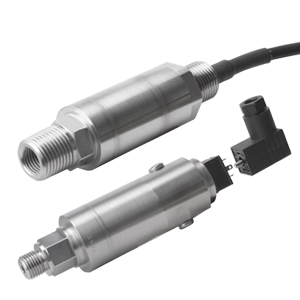
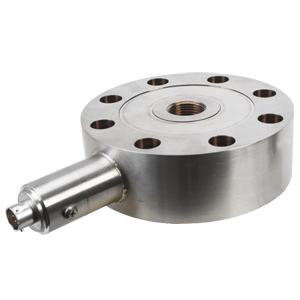
Is Intrinsic Safety Certified Equipment More Expensive than Non-certified Versions?
Typically equipment with an Intrinsic Safety certification is slightly more expensive than
non intrinsic versions. This results more from obtaining and maintaining the approval than from the cost of additional or uncommon components. The basic design of an IS barrier uses Zener Diodes to limit voltage, resistors to limit current and a fuse, none of which are expensive.
What are the Benefits?
When electrical equipment and instrumentation must be placed in a hazardous environment, Intrinsic Safety barriers offer several benefits.
- It helps ensure a safe work environment and protects those nearby from explosion risks.
- It avoids the cost and bulk of explosion proof enclosures. Additional cost savings accrue from the ability to use standard instrumentation cables.
- Maintenance and diagnostic work can be performed without shutting down production and ventilating the work area.
- Insurance premiums may be lower as a result of the reduction in risk.
Choosing Pressure Transducers or Load Cell for Intrinsic Safety Environments

For equipment to qualify as Intrinsic Safety it must be certified as such. Equipment without such marking must not be used in hazardous environments unless other appropriate precautions are taken.
Installation and Risk Management Considerations
Installation is easier than setting up explosion proof enclosures. It is important to note that the whole system must be designed to be intrinsically safe. It is not sufficient just to purchase pressure sensors or load cells with Intrinsic Safety certification.
A system designed to be intrinsically safe requires full documentation of all the components and wiring employed. Immediately following installation there will be an inspection, followed by periodic inspections through the life of the equipment. This is to identify any deterioration or damage that may have occurred and any unapproved or unauthorized replacement of Intrinsic Safety system components.
Insulation and ground testing normally form part of an electrical inspection. However, such practices are not normally compatible with the IS concept. Specialist advice should be sought if these tests are needed.
A system designed to be intrinsically safe requires full documentation of all the components and wiring employed. Immediately following installation there will be an inspection, followed by periodic inspections through the life of the equipment. This is to identify any deterioration or damage that may have occurred and any unapproved or unauthorized replacement of Intrinsic Safety system components.
Insulation and ground testing normally form part of an electrical inspection. However, such practices are not normally compatible with the IS concept. Specialist advice should be sought if these tests are needed.
General Q&A
Does Intrinsically Safe equipment replace explosion proofing or pressurization?
No, intrinsically safe apparatus cannot replace these methods in all applications due to the reliance on low power and temperature. Where it is possible it often leads to significant savings in installation and maintenance costs.
Does Intrinsic Safety affect the performance of the certified device?
No, the performance is the same as the as the non-certified with higher reliability. These devices use the same parts as the non-certified device but have been designed to limit the energy stored and heat generated in case of an internal fault condition.
No, intrinsically safe apparatus cannot replace these methods in all applications due to the reliance on low power and temperature. Where it is possible it often leads to significant savings in installation and maintenance costs.
Does Intrinsic Safety affect the performance of the certified device?
No, the performance is the same as the as the non-certified with higher reliability. These devices use the same parts as the non-certified device but have been designed to limit the energy stored and heat generated in case of an internal fault condition.
Protecting People and Property
Many industrial, chemical and process environments have significant explosion risks, either due to the presence, actual or possible, of flammable gases and vapors, dusts or fibers. Such environments are termed “hazardous” and it is essential that they are designed so as to eliminate the possibility of igniting the flammable material.
Often it’s necessary to incorporate instrumentation of an electrical nature in such environments. When this is unavoidable there are three possible approaches: put the equipment in an explosion proof enclosure, purge the enclosure with inert gas, or adopt Intrinsic Safety design principles.
IS design minimizes power and heat creation. Equipment must be independently certified as Intrinsic Safety, and the whole system must be designed to IS standards before entering service. However, adopting IS design can simplify installation, save money, enable maintenance on live equipment, and most importantly, makes for a safer workplace.
Often it’s necessary to incorporate instrumentation of an electrical nature in such environments. When this is unavoidable there are three possible approaches: put the equipment in an explosion proof enclosure, purge the enclosure with inert gas, or adopt Intrinsic Safety design principles.
IS design minimizes power and heat creation. Equipment must be independently certified as Intrinsic Safety, and the whole system must be designed to IS standards before entering service. However, adopting IS design can simplify installation, save money, enable maintenance on live equipment, and most importantly, makes for a safer workplace.
Intrinsic safety certification in the world
Intrinsic safety equipment must have been tested and approved by an independent agency to assure its safety. The customer should specify the type of approval required for their particular application. The most common Agencies involved are as follows:
Country AGENCY
USA - FM, UL
CANADA - CSA
GREAT BRITIAN - BASEEFA
FRANCE - LCIE
GERMANY - PTB
ITALY - CESI
BELGIUM - INEX
NOTE: approval by any of the above European Agencies constitutes a CENELEC approval allowing the units to be considered approved in many of the European countries.
Products to be mounted in the hazardous area can be approved either under the LOOP or ENTITY approval concept.
The LOOP concept specifies the exact part number and products that can be used in the loop. No deviation from the specified units is allowed.
The ENTITY concept specifies parameters which any approved intrinsic safety barrier must meet. This allows the user to select intrinsic safe barriers from different approved manufacturers. Under entity approval two items may be interconnected if the following conditions are met (refer to chart below):
Country AGENCY
USA - FM, UL
CANADA - CSA
GREAT BRITIAN - BASEEFA
FRANCE - LCIE
GERMANY - PTB
ITALY - CESI
BELGIUM - INEX
NOTE: approval by any of the above European Agencies constitutes a CENELEC approval allowing the units to be considered approved in many of the European countries.
Products to be mounted in the hazardous area can be approved either under the LOOP or ENTITY approval concept.
The LOOP concept specifies the exact part number and products that can be used in the loop. No deviation from the specified units is allowed.
The ENTITY concept specifies parameters which any approved intrinsic safety barrier must meet. This allows the user to select intrinsic safe barriers from different approved manufacturers. Under entity approval two items may be interconnected if the following conditions are met (refer to chart below):
| Intrinsically Safe Approved Apparatus | Must be | Intrinsically Safe Barrier |
| Voc | less than | Vmax |
| Imax | less than | Isc |
| La | greater than | Li + Lw |
| Ca | greater than | Ci + Cw |
| Where: | |
| Vmax = | Maximum Open Circuit Voltage |
| Imax = | Maximum Short Circuit Current |
| L = | Maximum Unprotected Inductance |
| Ci = | Maximum Unprotected Capacitance |
| Voc = | Maximum Open Circuit Voltage (electrical safety barrier) |
| Isc = | Maximum Short Circuit Current (barrier) |
| La = | Maximum Allowed Inductance (barrier) |
| Ca = | Maximum Allowed Capacitance (barrier) |
| Lw = | Inductance of interconnecting wiring |
| Cw = | Capacitance of interconnecting wiring |
In all cases the intrinsically safe barriers and equipment MUST be wired per an approved drawing.
Intrinsically Safe Pressure Transducer | Tech Reference
Intrinsically Safe Pressure Transducer | Related Products
 CLOSE
CLOSE


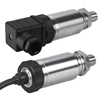
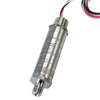
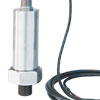
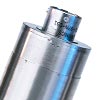
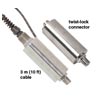
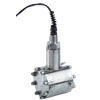
 In the airline industry weight is money. Every additional pound requires more fuel to lift...
In the airline industry weight is money. Every additional pound requires more fuel to lift...
 How to use strain gauges and optimize their performance while working with inhomogeneous materials
How to use strain gauges and optimize their performance while working with inhomogeneous materials
 Understand the necessary criteria to select the right type of pressure transducer for your application
Understand the necessary criteria to select the right type of pressure transducer for your application